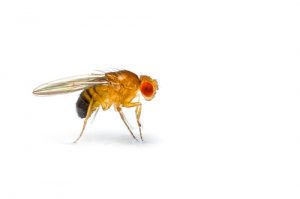Where do ‘Fruit Flies’ Come From?
By Chris Williams on July 11, 2011.
Q: Where do ‘fruit flies’ come from? It’s almost as if they appear by ‘spontaneous generation’!
A: If you mean the slow-flying ones that just sort of show up when the bananas on the kitchen countertop become over-ripe, there are several possibilities, but first, let’s look at the insect. The real common name for this group of flies that are attracted to over-ripe fruits, vegetables, and other fermenting organic material is vinegar flies. Vinegar flies belong to the family Drosophilidae. This is a very large group with several thousand species in sixty different genera, and can be found worldwide. By far the largest numbers of species (over half, and including the most common ones in North America) belong to a single genus Drosophila. Of these, Drosophila melanogaster has been used extensively to help broaden our knowledge of genetics. It’s contribution to science not withstanding; vinegar flies can be a serious nuisance pest in restaurants, taverns, fruit markets, canneries, and breweries. Adult vinegar flies are attracted to the odors given off by over ripe tomatoes, apples and other produce in commercial growing operations as well as the home garden.
 It is very easy to introduce them into your home on backyard grown tomatoes. For example, adult flies will deposit eggs in the cracks that sometimes develop as the tomato ripens. Newly hatched larvae will feed upon yeast cells in the liquid as that ‘perfect’ tomato begins to break down. They spend as little as five days developing before leaving the food source to pupate and then emerge as an adult fly just in time to attack those bananas! Under optimal conditions, these flies can complete their life cycle in a little as eight days and begin producing a new generation in just a few more.
It is very easy to introduce them into your home on backyard grown tomatoes. For example, adult flies will deposit eggs in the cracks that sometimes develop as the tomato ripens. Newly hatched larvae will feed upon yeast cells in the liquid as that ‘perfect’ tomato begins to break down. They spend as little as five days developing before leaving the food source to pupate and then emerge as an adult fly just in time to attack those bananas! Under optimal conditions, these flies can complete their life cycle in a little as eight days and begin producing a new generation in just a few more.
So you don’t like bananas, you’re allergic to tomatoes, and yet your home is inundated with vinegar flies. Other fly breeding sources often overlooked are onions and potatoes that have begun to break down. Also, with most communities today having some form of curbside recycling, un-rinsed beer, wine, soda bottles, and cans sitting in the bin in the garage will have plenty of liquid residue to support vinegar fly larvae. Finally, the same type of gelatinous build up in drains that humpback and moth (drain flies) thrive on will also support vinegar flies as well.
 As is the case with most (if not all) good pest management, the first step to successful control of vinegar flies is to identify and eliminate breeding sites both inside and outside the home. Colonial Pest Control’s pest management technicians are experts at finding the sources critical for nuisance fly control success!
As is the case with most (if not all) good pest management, the first step to successful control of vinegar flies is to identify and eliminate breeding sites both inside and outside the home. Colonial Pest Control’s pest management technicians are experts at finding the sources critical for nuisance fly control success!